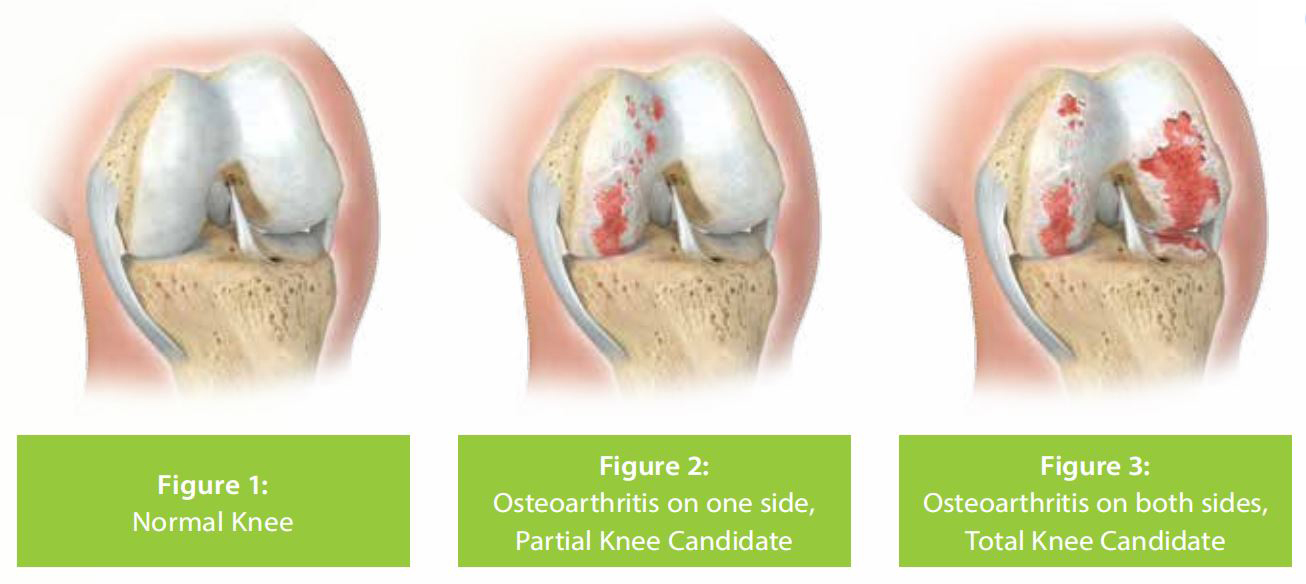There are many treatment options to consider when suffering with arthritis, such as medication or non-surgical treatment,including exercise and physiotherapy. However, knee replacement surgery may be recommended if there is significant arthritis of the knee. This leaflet is designed to give more information about Partial Knee Replacement so you can make an informed decision.With total knee replacement, the entire surface of the knee is removed.But with Partial Knee Replacement, you can keep up to 75% of your healthy knee – for a more rapid recovery1 with more natural motion.
Arthritis
Healthy joints are covered by a layer of cartilage which is a tough, lubricating tissue that provides smooth, pain-free motion to your joints. Arthritis or ‘joint inflammation’, can be an extremely painful and difficult condition to manageWhen arthritis develops, the cartilage becomes thinner, and eventually wears away down to the bone. This may happen gradually, with normal wear, or perhaps because of a small injury which can make joints more likely to develop arthritis at a later date. Without cartilage, walking is painful and in some cases impossible.
What is Osteoarthritis?
The most common form of arthritis is osteoarthritis. Osteoarthritis or “wear-and-tear” arthritis, is a condition where the surface of the joint is damaged and the surrounding bone grows thicker, resulting in bone against bone friction. This friction can cause severe pain and eventually loss of movement. It is commonly believed that osteoarthritis only occurs in older people, though it can in fact also appear as a secondary condition in younger people.
Symptoms of osteoarthritis can include:
• Painful joints, especially after activity or periods of inactivity
• Joint stiffness
• Joint swelling
• Loss of movement in the joint
Stages of Osteoarthritis: Knee Replacement Options

What is Total Knee Replacement?
The knee joint is one of the largest and most complex joints in the body. It consists of three parts which move and work together to ensure smooth motion and function. The knee is made up of the lower end of the thigh bone (femur, Figure 6) which rotates on the upper end of the shin bone (tibia, Figure 6) and the kneecap (patella) which slides in a groove on the end of the femur. Four large ligaments attached to the femur and the tibia provide stability. Total Knee Replacement removes the entire surface of the knee joint and replaces that surface with artificial parts. A Total Knee Replacement will consist of the following components (Figure 4):
• The femoral component: a metal component on the end of the thigh bone
• The tibial component: a metal and plastic liner on the upper end of the shin bone
• If needed: a plastic button on the kneecap
What is Partial Knee Replacement?
In the early stages of osteoarthritis, often only one side of the knee is damaged. This is usually the inner side (Figure 6) of the knee but, although less common, arthritis can also affect the outer side (Figure 6) of the knee. By having a Partial Knee Replacement before the disease progresses, you may be able to prevent osteoarthritis from spreading, and avoid having to undergo a Total Knee Replacement.
A Partial Knee Replacement, also known as a uni-compartmental knee replacement, will replace only the damaged side of the knee (Figure 2), preserving the undamaged cartilage. This may result in a smaller incision, keeping the four natural ligaments and an artificial joint which functions more like the natural knee movement.
There are two main types of Partial Knee Replacement; fixed bearing and mobile bearing. Your surgeon will decide what is best for you based on the anatomy of your knee and your condition. The bearing, or liner, on a mobile bearing knee replacement (Figure 5) is able to move backwards and forwards as the knee bends or straightens. By allowing the knee to move more naturally, there is decreased wear of the bearing (liner). With fixed bearing Partial Knee Replacement, the bearing does not move like the natural knee, which may lead to an increased chance of the bearing wearing out over time.


Ligament Preservation
By undergoing a Partial Knee Replacement the soft tissues, ACL (Anterior Cruciate Ligament) and PCL (Posterior Cruciate Ligament), are kept intact and are not removed. These ligaments help provide stability, balance, and maintain your natural movement after surgery. Recent research has found that approximately 50% of knee replacement patients have an undamaged ACL and are potential candidates for partial knee replacement.
With Total Knee Replacement the natural ligaments, the ACL and PCL, are often removed (Figure 7). The implant must then provide the stability to the knee instead of the natural ligaments. With modern materials and improvements in techniques and antibiotic therapy, Total Knee Replacement can be a successful operation.

Benefits of Partial Knee Replacement vs. Total Knee Replacement
There are many reasons that Partial Knee patients are happier and more satisfied with their knee replacement compared to Total Knee Replacement patients.
There are many things to consider when choosing the right treatment for knee arthritis and your orthopaedic surgeon should take your goals following a knee replacement into account. The orthopaedic surgeon will consider many factors, such as age, bone density and the shape of joints to determine the most appropriate type of knee replacement for you.
• Partial Knee patients are over twice as likely to be satisfied with their ability to perform daily activities, such as using the stairs or getting out of the car*4
• Partial Knee Replacement patient’s knees are more likely to feel “normal”4
• A higher percentage of Partial Knee patients have reported feeling “Very Happy” with their knee replacements*
